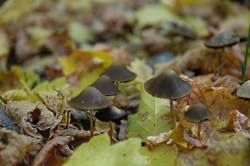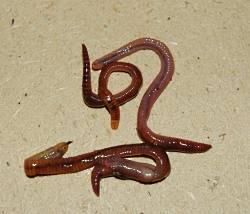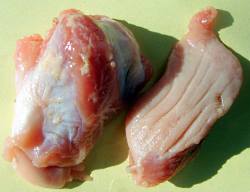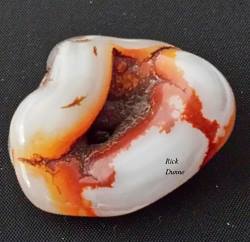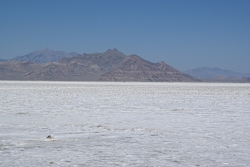
as seen from Interstate 80
East of Wendover, UT
Courtesy Wikimedia
Hermann Luyken, Photographer
Image licensed through
Creative Commons
CC0 1.0 Universal Public Domain Dedication
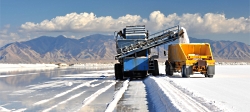 Salt Production
Salt Production
Solar Evaporation
Courtesy Morton Salt, Inc.
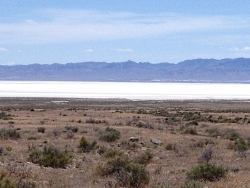 Sevier Lake
Sevier Lake
Courtesy & Copyright 2013
Holly Strand, Photographer
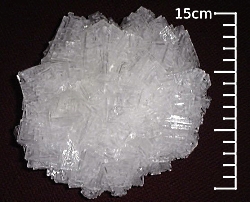 Salt Crystal
Salt Crystal
Minerals and Materials Photo Gallery
U.S House Subcommittee
on Energy and Natural Resources
Hi, I’m Holly Strand from the Quinney College of Natural Resources at Utah State University.
Throughout history, salt has held enormous significance for human society. And not just because it makes food taste better. Salt is a biological necessity. The human body needs a small but regular supply of sodium to maintain a balance of body fluids, keep muscles and nerves running smoothly and help certain organs work properly.
Thousands of years ago, salt was discovered to have another vital function– as a food preservative. This discovery quickly transformed the human lifestyle. For if people could preserve their food, they no longer had to depend upon the seasonal availability of food. Further, preservation allowed people to travel over long distances with a portable food supply.
Because of its central importance to health and human welfare, salt acquired some interesting forms of cultural significance as well. For instance, spilling salt is a bad omen. But you can mitigate by throwing the spilled salt over your left shoulder into the eyes of the Devil that lurks there. In many places salt was used as money. The English word “salary” comes from the Latin phrase salarium argentum, or “salt money,” which was paid to Roman soldiers.
Before the evolution of modern geology and extraction techniques, salt was difficult to find and to remove. The limited supply led to increased demand. In Salt: A World History author Mark Kurlansky described how salt demand spawned extensive trade routes, alliances, and even empires. Salt taxes were a common source of government income as well as a cause for revolt.
Here in Utah, it’s hard to imagine getting worked up about salt supply. There’s just so much of it lying around. That’s because as the 20,000 square miles of water that was Lake Bonneville evaporated, salt was precipitated all over the dried up lake bed.
The Great Salt Lake itself contains about 4.5 billion tons of salt. Currently 3 corporations extract salt using over 80000 acres of solar evaporation ponds near the lake. They produce over 2 millions tons of salt per year. This roughly equals the amount of salt flowing into the lake. For the Bear, Weber and Jordan Rivers add about 2.2 million tons of salt annually.
Utah and nearby states use the Great Salt Lake salt for de-icing roadways. Some of the salt is pressed into pellets for water softeners. Ranchers get salt-lick blocks for their livestock. And huge quantities of bulk salt are used in metal, chemical, paper and other industries.
Food grade or table salt is not produced from the Great Salt Lake area. However Redmond Minerals Inc. produces table salt in Sevier County.
For Wild About Utah, I’m Holly Strand.
Credits:
Image: Courtesy Wikimedia, Hermann Luyken, Photographer, Image licensed through Creative Commons CC0 1.0 Universal Public Domain Dedication
Image: Courtesy & Copyright Morton Salt, Inc.
Image: Sevier Lake, Courtesy & Copyright 2013 Holly Strand
Image: Courtesy U.S House Subcommittee on Energy and Natural Resources, Public Domain
Text: Holly Strand
Sources & Additional Reading
Wild About Utah pieces authored by Holly Strand
Freeman, Shanna. 2007. “How Salt Works” HowStuffWorks.com. https://science.howstuffworks.com/innovation/edible-innovations/salt.htm
Gwynn, Mark, Ken Krahulec, and Michael Vanden Berg. Utah Mining 2010, Utah Geological Survey of Utah Department of Natural Resources, https://ugspub.nr.utah.gov/publications/circular/c-114.pdf Circular 114
Gwynn, J. Wallace, ed. Great Salt Lake: an overview of change. 2002. DNR Special Publication. Utah Geological Survey of Utah Department of Natural Resources. formerly at: https://wildlife.utah.gov/gsl/gsl_cmp_resource_doc/10minerals.pdf
Kurlansky, Mark. 2003. Salt: A World History. London: Penguin Books. https://www.amazon.com/Salt-World-History-Mark-Kurlansky/dp/0142001619
Salt Institute. A non-profit trade association dedicated to advocating the many benefits of salt. https://www.saltinstitute.org/ [Dissolved March 2019]
Stephens, Doyle W. and Joe Gardner USGS. Great Salt Lake, Utah https://pubs.usgs.gov/wri/wri994189/PDF/WRI99-4189.pdf
USDA. Sodium in Your Diet: Using the Nutrition Facts Label to Reduce Your Intake. https://www.fda.gov/Food/ResourcesForYou/Consumers/ucm315393.htm

